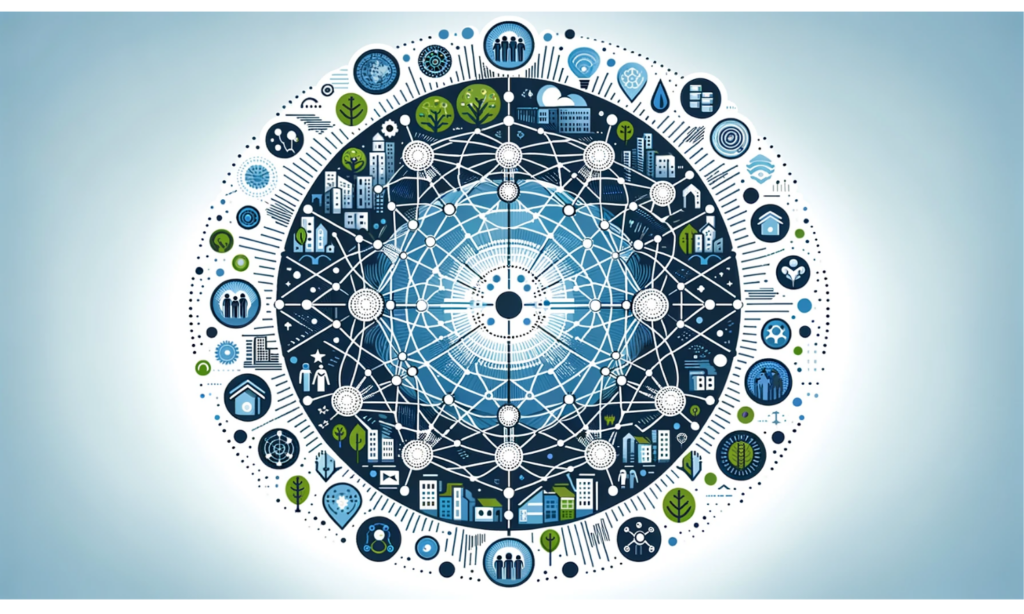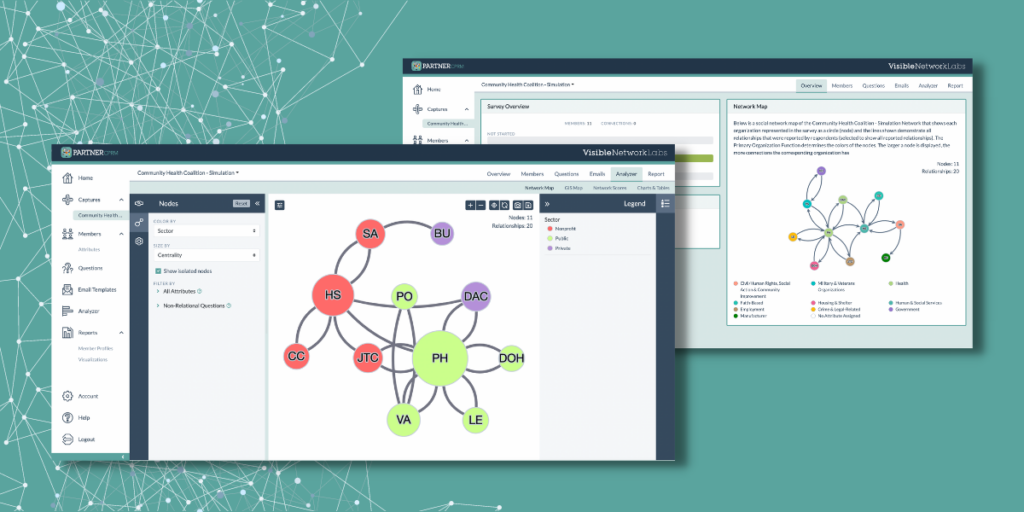In today’s rapidly changing world, the concept of resilience has never been more critical, especially when it comes to managing community networks. Resilience in systems thinking is the ability of a system – like a network of community partners – to withstand and adapt to challenges while maintaining its core purpose. For professionals in social sectors, understanding and applying this concept is key to building effective and sustainable partnerships.
In this article, we’ll dig into resilience, learn what it means, and share 7 tips for building resilient community networks using lessons from systems theory.
Table of Contents
What is Resilience?
Systems thinking offers a holistic approach to understanding the interconnectivity and interdependence within networks. It recognizes that each element within a system impacts and is impacted by others. Resilience in this context is about the system’s capacity to absorb stress, recover from disruptions, and continue to develop and grow in the face of challenges.
Resilient networks typically exhibit self-organization, adaptability and redundancy, allowing them to adjust in the face of change. They are also characterized by diversity in membership and flexibility in structure and function, with a demonstrated robustness against shocks from unforeseen obstacles.

Get our monthly newsletter with resources for cross-sector collaboration, VNL recommended reading, and upcoming opportunities for engaged in the “network way of working.”
Why Resilience is Key for Healthy Systems
All systems operate in an environment, subjected to constant challenges and threats to its existence in the form of shocks and changes to its inputs. For example, in a public health emergency like a pandemic, the number of the sick, hospitalized, and dying rises dramatically and threatens to overwhelm public health and healthcare systems unable to quickly adapt to the growth in demand without breaking under the pressure.
During the recent COVID-19 pandemic, we saw many examples of systems adapting and demonstrating resilience in the face of unprecedented challenges to their survival. For example, the system adapted and approved federal and state funding to expand the capacities of the public health system and boost support for development of a vaccine.
At the local level, public health departments activated existing networks and partnerships to respond to the crisis, access key resources and information, collect data, disseminate resources, PPE, and the vaccine to the public.
While the system did not succeed in all aspects, its ability to respond in the face of a huge challenge prevented the failure of the overall public health system, saving the lives of millions of people had the virus rage unimpeded across the nation and vaccine been delayed for years.

6 Major Components of Resilience
From a systems perspective, resilience is an result of the following important factors and processes:
Redundancy: Having multiple ways to fulfill a function or task within the system. This redundancy ensures that if one part fails, others can compensate, maintaining the system’s overall functionality.
Diversity: A diverse system with a variety of components and functions is more resilient. Diversity in skills, processes, and approaches can provide alternative ways to respond to challenges and changes.
Connectivity: The way a system’s parts are connected affects resilience. Too little connectivity can mean that resources and information don’t flow effectively. However, too much connectivity can lead to the spread of disturbances and waste resources.
Adaptability: The ability of a system to adjust its functioning in response to changes in the environment is crucial. Adaptability involves learning and surveillance, experimenting, and developing new strategies.
Self-Organization: The ability of a system to learn, diversify, and complexity through its structure, connectivity, and hierarchies. Being able to do so, without external control, can be crucial in responding to change and uncertainty quickly.
Reserve Stocks: Having extra capacity or resources that can be deployed in times of stress helps in handling unexpected disturbances. Creating trust with partners during good times provides social capital to call upon when times are more challenging.
Understanding these six network dynamics and how they influence resilience is important to build stronger systems that can bounce back in times of crisis. Without resilience, a system can collapse or fail to respond in an emergency, as we have seen in multiple different communities and sectors.
What Happens When a System Lacks Resilience
One instance where a system demonstrated a lack of resilience, leading to a significant crisis, is the response to the HIV/AIDS epidemic in the United States during the early 1980s. This period marked a crucial time when the public health system was unprepared and slow to respond to a rapidly emerging health crisis, resulting in widespread consequences.
In the early stages of the epidemic, there was a significant delay in recognizing the severity and nature of the disease. The public health system was slow to respond to the emerging crisis, partly due to a lack of understanding and initial underestimation of the virus’s impact.

There was also insufficient funding and resources allocated to HIV/AIDS research, treatment, and education. This lack of investment slowed the development of effective medical responses and public health strategies.
Lastly, there was a lack of effective policies and coordinated national efforts to address the epidemic during the initial years. The response was fragmented and often varied significantly from one region to another.
The slow response and failure to adapt demonstrated a lack of resilience in the public health system rooted in a lack of diversity and understanding of the LGBT community in the United States at the time.
Stigma and prejudice initially prevented the system from learning and adapting to address the crisis, underscoring the importance of inclusivity when creating systems that provide a range of perspectives to speed up adaptation.
Creating Resilient Collaborative Ecosystems and Networks: 7 Tips
Resilience is a component of most healthy systems, including your ecosystem of community partners. Create a healthy and resilient structure that can learn and adapt by following these seven tips from our team:
1. Foster Diversity and Inclusivity:
A diverse network brings a wide range of ideas, skills, and experiences, which can be crucial in responding to varied challenges. It also provides new perspectives to help identify threats and crisis and learn and adapt more quickly.
2. Promote Redundancy in Roles and Functions:
Ensure that critical functions and roles within the network are not dependent on single points of failure. Having multiple entities or individuals capable of performing essential tasks can prevent system breakdowns.
3. Enhance Connectivity and Communication:
Build strong lines of communication across the network. Effective information flow is key to coordination and timely response. However, be mindful of over-connectivity which can lead to dependency and vulnerability.

4. Implement Adaptive Learning:
Encourage continuous learning within the network. Use data, feedback, and experiences to inform decisions and adapt strategies. PARTNER CPRM, for example, can be used to gather and analyze network data, aiding in this adaptive process.
5. Build Capacity for Self-Organization:
Empower community partners to self-organize and collaborate independently. This could involve training, sharing best practices, and providing tools and PARTNER CPRM data and member profiles that facilitate autonomous collaboration.
6. Encourage Decentralization Where Appropriate:
While coordination is key, overly centralized systems can become bottlenecks. Allow for autonomy and decision-making at various levels of the system to enhance responsiveness and flexibility during an emergency.
7. Develop a Culture of Trust:
Build a network culture based on trust, transparency, and mutual respect. Trust is the foundation of collaboration, especially in times of crisis, and transparency fosters accountability and better communication.

Get our monthly newsletter with resources for cross-sector collaboration, VNL recommended reading, and upcoming opportunities for engaged in the “network way of working.”
Build A Resilient Network of Community Partners with PARTNER CPRM
PARTNER CPRM is a powerful tool for community partnership management, ideal for enhancing the resilience of public health systems. At its core, PARTNER CPRM leverages advanced network science to map, analyze, and visualize the intricate web of community connections and interactions. The platform offers unique insights into the dynamics of your network, enabling organizations to not only visualize but also strategically manage these relationships for greater impact.
With PARTNER CPRM, public health systems can monitor and assess the strength, quality, and evolution of their partnerships. The tool’s intuitive interface and robust analytical capabilities make it easy to identify key players, track the flow of information, and evaluate the effectiveness of collaborative efforts. This insight is critical for adapting to changes, allocating resources efficiently, and enhancing overall network health.

Learn More & Request a 1:1 CPRM Demo
To truly understand how PARTNER CPRM can transform your approach to community partnership management, we invite you to experience it firsthand. Request a personalized 1:1 demo to explore the capabilities of this innovative platform. During the demo, our expert team will walk you through the various features of PARTNER CPRM, demonstrating how it can be tailored to your specific needs and objectives.
Resilience is Critical for Community Collaboration
In conclusion, the resilience of public health systems is not just a matter of resources and infrastructure; it’s about how effectively these systems can adapt, learn, and collaborate in the face of challenges. The tips provided in this blog underscore the importance of systems thinking and theory in building networks that are not only robust but also adaptive and responsive to changing needs and environments.
As we move forward in an increasingly interconnected world, the role of resilient public health systems becomes ever more crucial. Through tools like PARTNER CPRM and a commitment to systems thinking, we can ensure that our communities are not only prepared for the challenges of today but are also laying the groundwork for a healthier, more collaborative future.
Additional Resources
Here are some additional resources, articles, and webinars about community and systems resilience. If you have a related resources to add, post a comment with it below and we will add it in our next article update.
- What is community resilience? (Urban Footprint)
- Community resilience resources and articles (RAND Corporation)
- Developing resilience solutions through systems thinking (SSTi)
- How to Use Systems Thinking to Solve Tough Resilience Problems and Get Stuff Done (CA Adaptation Forum)
- A Call for Social Resilience 10 Years After Hurricane Sandy (Visible Network Labs)
- Community Partnerships Addressing Community Resilience: A Network Evaluation (Visible Network Labs)
- Webinar: Building Resilient Community Networks in Challenging Times (Visible Network Labs)
FAQs
If we haven’t addressed your question yet below, leave a comment and our team will get back to you with more information as soon as possible.
Q: What is a resilient network?
A: A resilient network is a system of interconnected entities – such as individuals, organizations, or communities – that can effectively withstand and adapt to challenges while maintaining its core functions. These networks are characterized by their ability to recover quickly from disruptions, adapt to changing conditions, and continue evolving to meet new demands.
Q: How do you build network resilience?
A: Building network resilience involves several key strategies:
- Fostering Diversity: Incorporating a wide range of ideas, skills, and experiences.
- Promoting Redundancy: Ensuring critical functions are not dependent on single points of failure.
- Enhancing Connectivity: Building strong communication lines while avoiding over-dependency.
- Implementing Adaptive Learning: Using data and feedback to inform decisions and strategies.
- Encouraging Self-Organization: Allowing for autonomous collaboration and decision-making.
- Developing Trust: Establishing a culture of transparency, mutual respect, and shared values.
Q: Why is resilience important in network design?
A: Resilience is crucial in network design to ensure the network’s longevity, effectiveness, and adaptability. Resilient networks are better equipped to handle uncertainties and challenges, such as natural disasters, economic shifts, or technological disruptions. This makes them more reliable and effective in achieving their objectives over the long term.
Q: What is an example of a resilient system?
A: An example of a resilient system is the global internet network. Despite various challenges, including cyber-attacks, hardware failures, and policy changes, the internet continues to function and evolve due to its decentralized structure, redundant pathways, and continual innovation.
Q: What are the properties of a resilient system?
A: Key properties of a resilient system include:
- Robustness: The ability to maintain core functions despite disturbances.
- Redundancy: Multiple ways to fulfill essential functions.
- Flexibility: Capability to change and adapt in response to new conditions.
- Resourcefulness: Effective use of available resources to respond to challenges.
- Rapid Recovery: Quick restoration of functionality after a disruption.
Q: Why is collaboration important in resilience?
A: Collaboration is vital in resilience because it brings together diverse perspectives, resources, and skills. This diversity enhances the network’s ability to identify potential threats, generate creative solutions, and distribute resources efficiently. Collaboration fosters a supportive environment that is essential for adaptive learning and shared problem-solving.
Q: How do you build resilience in collaboration?
A: Building resilience in collaboration involves:
- Establishing Clear Communication: Ensuring all members understand goals, roles, and processes.
- Creating Shared Values and Vision: Aligning all members towards common objectives.
- Encouraging Diversity: Valuing different perspectives and skills.
- Promoting Transparency: Sharing information openly to build trust.
- Facilitating Adaptive Leadership: Leaders who can guide the network through change and uncertainty.
- Implementing Feedback Loops: Using insights and feedback for continuous improvement.







